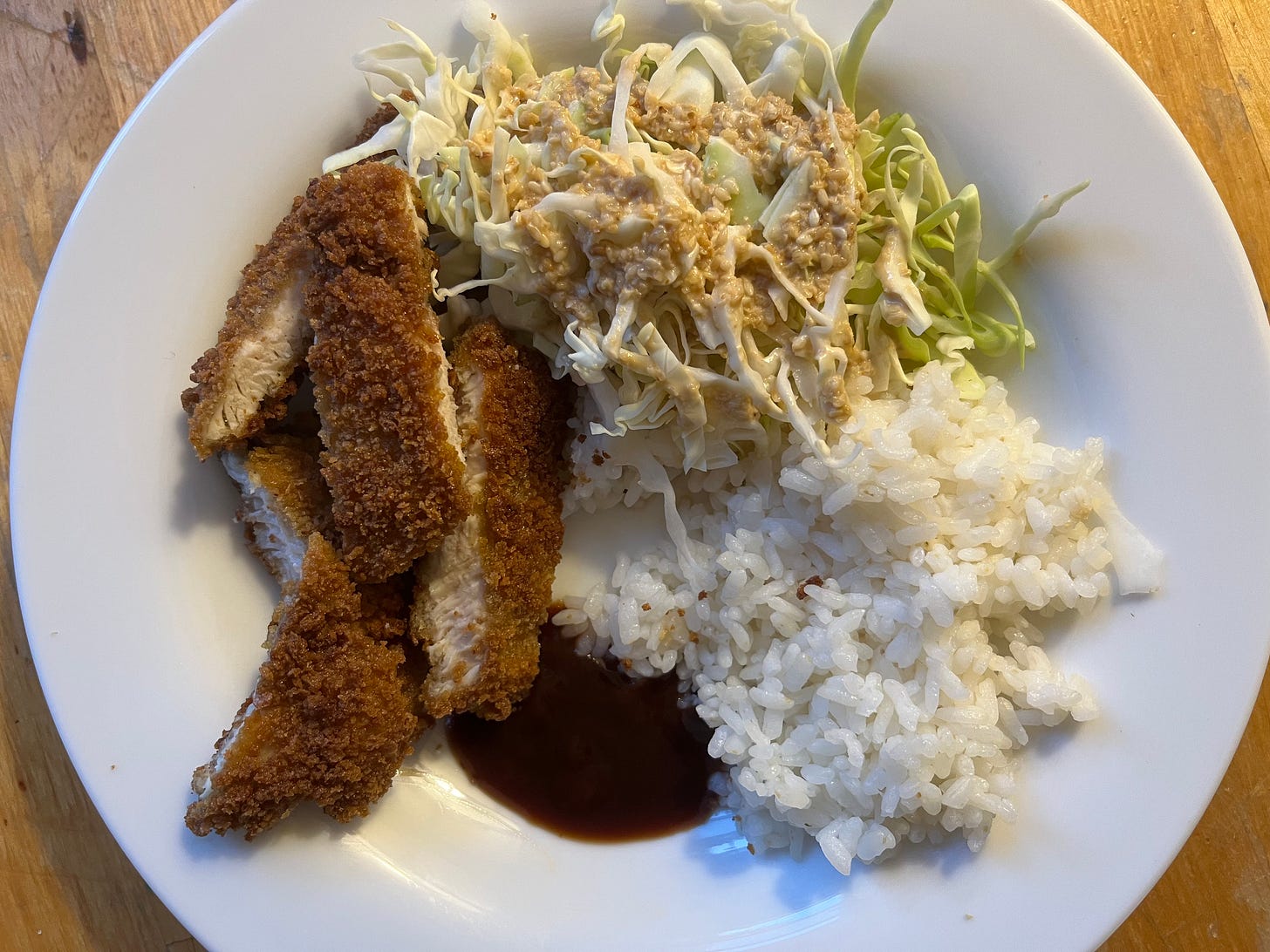Equinox sunrise at Brighton Beach, trusting your intuition, the best Japanese chicken cutlet dinner,
and R.I.P Powerglow Life...
Hello everyone! Happy Spring Equinox! On Wednesday morning Dan and I took the girls to Brighton Beach to watch the Equinox sunrise. I took the girls last year, and now that we’ve done it twice, it’s officially a tradition! After the sun came up, we got some fresh-out-of-the-oven savory Uzbek pastries (some filled with beef and onion and some filled with pumpkin) at Kaffeine 231, and hot, fresh Turkish pastries (some filled with beef and some filled with cheese), plus tiny cups of Turkish coffee to-go at Gulluoglu Cafe, and brought them back to the beach for a fantastic breakfast. It was COLD, and the wind was whipping, and somehow that made the hot pastries and coffee even more delicious.
Ultimately, it was one of those outings that was about 80% fun. It felt memorable and special, the sunrise was gorgeous, the empty beach was peaceful and beautiful, and the pastries were out of this world. But there was also the challenge of getting out of the apartment at 6am, the girls bickering in the car on the way there, and then on the way back hitting a ton of traffic, getting the girls to school late, and to top it all off, spending 45 minutes looking for a parking spot in our neighborhood. But that’s life with kids/life in NYC/life in general, right? 80% fun is actually a pretty high percentage, I would say.
In other news, I killed off our hard won sourdough starter—Powerglow Life. As I wrote about a few newsletters back, I had decided that it was worth keeping alive to use for “discard” baking, even though I had realized that I really don’t currently have a life/lifestyle that allows for the 35 hour sourdough bread baking process. But then, even that felt like too much work. So I threw it out (after about a week of neglect, which had caused it to start to rot).
Part of me feels very sheepish sharing this, but on the other hand, I feel like I learned a ton from the process and the whole struggle to get it going, and I now know how to successfully start and maintain a starter, if/when I want to do it again. My two main takeaways—make a yeast starter liquid first from raisins, water, and honey, or buy a live starter online and use that to get off on the right foot (they’re very cheap and totally worth it).
What I’m Reading
I just finished reading a spiritual memoir called Letting Magic In: A Memoir of Becoming by an herbalist named Maia Toll. In terms of action, not that much happens—it starts in her late twenties when she was working as an elementary school teacher at a private school in Manhattan. From there she buys a small house in Beacon, NY and starts teaching at a school there. Then after a few years, she decides to sell her house and most of her possessions to move to Ireland to study with a traditional herbal healer with witchy leanings. The action of the book is really internal—the book traces her process of learning how to trust her intuition, and the way it ends up guiding her and helping her to feel more alive and connected.
In a way, I liked that that the action wasn’t super dramatic, and yet her inner transformation was significant. As someone who doesn’t have a life where I can just take off for 6 months of solo travel through India, I found it appealing to read about how she connected with magic and with her intuition within her mundane, everyday life. And in this funny way, the climax—moving to Ireland to study with an herbalist, felt kind of besides the point. Though it did make we want to go to Ireland to study with a witchy herbalist…
What I’m Cooking
This week I made one of our favorite family meals—Japanese chicken katsu (fried panko-breaded chicken cutlets) with homemade tonkatsu dipping sauce, shredded cabbage with sesame dressing, and white rice. This is definitely one of those meals that requires a significant investment of time and energy, but the payoff is really worth it. Plus, you can make a lot of breaded cutlets at once and either freeze them (breaded and raw) for a quick easy dinner another time, or you can eat them as delicious leftovers for the next several days (the girls love bringing them to school in their home lunches—they’re really the best chicken nuggets).
My chicken katsu recipe is a blend of approaches from the Just One Cookbook website, which I wrote about a while ago, and League of Kitchens Argentinian instructor Mirta’s chicken Milanese recipe. I use the basic ingredients from the Just One Cookbook website and the breading and frying techniques from Mirta (which I also wrote about in my fried fish recipe a couple of weeks ago).
I like to use organic panko bread crumbs, in addition to organic chicken breasts, organic/pastured eggs, and organic sprouted spelt flour (for dredging), and I shallow fry the chicken in an avocado/olive oil blend. This is definitely a recipe that can be made much healthier at home than what you can get at a restaurant.
It’s traditional in Japan to serve fried meats with raw shredded cabbage. The fresh crunchiness helps to balance out the richness of the fried food. But I just discovered through, internet research, that raw cabbage also has a chemical that helps the stomach digest fatty foods!
The tonkatsu sauce (the traditional sweet dipping sauce for Japanese fried meats), which I adapted from Just One Cookbook, is surprisingly easy to make—it’s just ketchup, Worchestershire sauce, and sugar. I use coconut sugar. The sesame dressing, also adapted from Just One Cookbook, uses ground toasted sesame seeds, soy sauce, mirin, rice vinegar, sugar, and mayo. It’s salty, tangy, and lightly creamy with a lot of umami, which makes it a nice complement to the other flavors in the meal.
You really need the rice to balance out the saltiness in the meal (that’s basically true for much of Japanese/Korean/Chinese cuisine). Basically you take a bite of rice, dip some breaded chicken cutlet (which you pre-cut into strips with scissors) into the tonkatsu sauce, and put that in your mouth to eat with the rice. It’s the same with eating the salad—you either eat it together with rice in the same bite or you alternate bites of salad with bites of rice.
Japanese chicken katsu with homemade tonkatsu sauce, shredded cabbage with sesame dressing, and white rice.
Serves 4-6
Ingredients for the Chicken:
4 boneless skinless chicken breasts (usually 2 packages)
salt
1/2 cup flour
3 cups panko breadcrumbs
2 large eggs
1 tablespoon avocado/olive oil blend, for the eggs
parchment paper
avocado/olive oil blend, for frying
Ingredients for the Tonkatsu Sauce—Makes 2 cups:
1 cup ketchup
3/4 cup Worcestershire sauce
6 tablespoons coconut sugar
Ingredients for the Sesame Dressing—Makes 1 cup:
6 tablespoons white sesame seeds
4 tablespoons mayonnaise (I use avocado oil mayo)
4 tablespoons unseasoned rice vinegar
2 1/2 tablespoons soy sauce
2 teaspoons coconut sugar
2 teaspoons toasted sesame oil
1 teaspoon Mirin
Ingredients for Serving:
1/2 a large green cabbage
cooked white rice
Directions for the Chicken:
Take each skinless boneless chicken breasts and cut it into 1/2 inch slices on the diagonal, starting at one end of the breast. (This is a Japanese cutting technique called Sogigiri. It’s faster and easier than cutting large cutlets along the full length of the breast.)
Season both sides of all the chicken slices with a sprinkling of salt.
Break the 2 large eggs into a bowl and whisk them with 1 tablespoon of avocado/olive oil blend. Place the 1/2 cup flour in a separate bowl.
Take a baking sheet and cover it with a piece of parchment paper. Pour about 1 cup of panko breadcrumbs in a pile into the middle of the sheet (you’ll keep adding more breadcrumbs, as you need them).
Prepare a large platter or pyrex baking dish (to receive the breaded cutlets) by lining it with a sheet of parchment paper.
With each slice of chicken, dredge it first in flour, shake off any excess, dip it into the egg, let the excess drip off, then place the chicken onto the pile of panko. Shake some additional panko from the package onto the chicken. Use your knuckles on your dominant hand to press and roll the breadcrumbs into the chicken. Flip the chicken. Lift the edges of the parchment to direct the panko onto the chicken. Use your knuckles to press and roll in the panko. Lift the breaded cutlet and gently shake it to release any excess panko. Then place it onto the parchment paper covered platter or baking dish. Repeat this process with all the chicken. (After you fill the platter/baking dish with one layer of cutlets, you can cover it with a sheet of parchment paper and add another layer, continuing to do so until you’ve breaded all the chicken.)
Take another baking sheet and cover it with a wire cooling rack. Cover 1/3 of the wire rack with paper towels (this is where you’ll drain the fried cutlets).
Add 1/4 inch of of avocado/olive oil blend to one or two nonstick skillets. (You can use two skillets to make the frying go faster.) Heat the pans on medium high. The oil is ready when you drop in a breadcrumb and it immediately floats and bubbles.
When the oil is hot, add the breaded cutlets. Cook them until the bottom is a deep golden brown, about 2-4 minutes. Flip and fry the other side until the color matches. If the cutlets are browning very quickly, lower the heat to medium.
When the cutlets are done, rest them first on the paper towel side of the wire rack. Then after about 5 seconds, move them to the uncovered wire side.
Directions for the Tonkatsu Sauce:
While the chicken is frying, combine the 1 cup ketchup, 3/4 cup Worcestershire sauce, and 6 tablespoons coconut sugar in a large bowl. Mix well with a spoon or whisk. Transfer the sauce to a jar or bowl for serving. (If you have extra sauce leftover, it keeps in the fridge for a long time—at least a couple of weeks.)
Directions for the Sesame Dressing and Cabbage:
While the chicken is frying, add the 6 tablespoons of white sesame seeds to a frying pan. Turn the flame on medium low. Watch the sesame seeds closely, shaking the pan often. Once they’ve started to turn a golden brown and smell toasty, turn off the heat.
Grind the sesame seeds in a spice grinder/coffee grinder or with a mortar and pestle until all of the seeds are broken up. If you’re using a spice grinder/coffee grinder, it requires just a few pulses—you don’t want them to turn into a paste.
Add the ground sesame seeds to a bowl. Add the 4 tablespoons mayonnaise (I use avocado oil mayo), 4 tablespoons unseasoned rice vinegar, 2 1/2 tablespoons soy sauce, 2 teaspoons coconut sugar, 2 teaspoons toasted sesame oil, and 1 teaspoon Mirin, and mix it all together with a spoon. Transfer it to a jar or bowl for serving. (It will keep in the fridge for up to a week.)
Take half a large green cabbage and shred it as thinly as you can with either a mandoline (use a protective glove!) or a knife.
To Serve:
If you want the chicken to stay extra crispy, serve it on the wire rack covered baking sheets at the table (if you move them to a plate, especially while hot, the bottoms will get slightly soggy). Use a kitchen scissors to cut each cutlet into strips. Give everyone some rice, some chicken strips, a spoonful of tonkatsu sauce, and some shredded cabbage topped with the sesame dressing.





